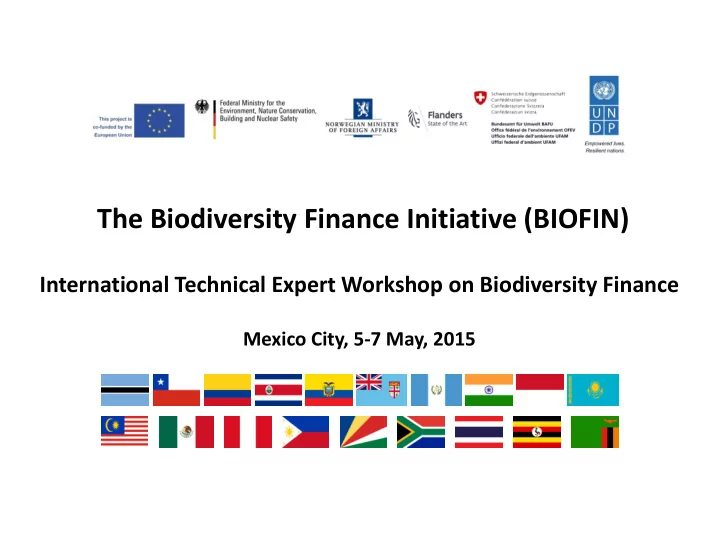

The Biodiversity Finance Initiative (BIOFIN) International Technical Expert Workshop on Biodiversity Finance Mexico City, 5-7 May, 2015
BIOFIN’s Approach to IDENTIFYING NBSAP (BIODIVERSITY) COSTS 2
Biodiversity / NBSAP Costing Main Steps • Planning • Identifying Structure and Taxonomy • Clarify NBSAP Activities / Results • Gathering and Refining Data • Analysis • Documentation, Reports and Synthesis 3
Planning • ID Target Biodiversity Action Plan • NBSAP Revisions – Peer Review and Common Challenges • Definition and Engagement of Stakeholders • Identification of Necessary Expertise 4
ID Structure and Taxonomy • International Reporting Standards (SEEA, CBD) • National Budget Codes / Reporting • BIOFIN / CBD Categories • National Taxonomy for Costing
BIOFIN Categories 6
Clarify NBSAP Activities / Results • Categories – BIOFIN, Aichi Targets, National Strategies • Clear Targets – Are they quantified? – Geographical? • Clear Activities / Actions / Programs • Specific Quantitative Results per Activities • Initial Costs Assessments • Reality Check - Cost Effectiveness, Cost Savings • Refinement of Activities / Results / Targets
Marlon’s 6 Commandments (for a Costable NBSAP) 1. The NBSAP should include a clear management hierarchy (MH) supported by result-based indicators for at least three levels: conservation results, cost-effectiveness and economic indicators* 2. The above indicated MH should be connected with sectors (line ministries’ programmes and policies) - sectoral responsibilities 3. The NBSAP should include defined sector priorities and a phased approach . 4. The NBSAP programs and activities leading to the achievement of the results are selected using a cost-effectiveness approach . 5. Sector ownership (line ministries including treasury) must be fully aware of their roles and responsibilities in the NBSAP. Overall endorsement from Treasury and the national planning agency is indispensable. 6. Link the NBSAP to other on going government priorities / policies - for example Climate Change Strategies / Sustainable Dev plans.
Gathering and Refining Data • ID point person in each key institution capable of providing data on costs • Develop Pre-Work Models and initial estimates • Unit costs and multiplication factors for each line item • Compare with government / other national cost matrices where available • Compare proposed unit costs with international examples • Low and High Costs – Low is minimum to get by or BAU (we are losing biodiversity rapidly), High is ideal, 80% or greater chance of attaining targets. • Feedback from Stakeholders • Choose final quantifiable target, number of units, unit costs and multiplication factors for each “Costable Activity Unit”. 9
Budgeting Refinements Pre-work & Experts NBSAP input Refinement Refine Refine Results Models Stakeholder Feedback
Analysis (1) Compare costs to the quantitative Results (and Targets) for each Activity (and Strategy) and ask: • Are the results worth the expense? • What might be the return on investment for this in terms of: economic, GDP, and potential taxation revenue? • Are there other options for achieving the same objectives without the cost identified? (Change in policy? Incentives? Enforcement? Etc.) • Who will be spending the money? Are they effective? Efficient? Are there alternatives? • Who may be financing the cost? Economic costs? • Are there other options for financing the cost that are/will: • Closely related to the target – i.e. polluter pays, user pays • Result in a positive change in behavior (i.e. sin taxes), etc. 11
Analysis (2) Review priority actions for each strategy considering: • Cost Effectiveness – scale of 1-5 with 5 being the most cost effective • Potential to be Tied to Finance Mechanism – no, maybe, yes (scale of 1-3) • Tag each for: main potential financer, manager, disburser, spender, beneficiary • These categories can be at least divided into Government, ODA, OOF, Corporations, Households, NGOs
Documentation Prepare Conclusions • Total Costs in each Aichi / BIOFIN category • Total Costs for each NBSAP Strategy/ Target • Total Cost by main Financier – source of financing • If possible – Total costs by Manager, Disburser, Spender, Beneficiary • Summary on opportunities for cost savings and efficiency • Summary of analysis on cost-effectiveness Reporting Report As in the BIOFIN Workbook pg. 52 13
Thank You www.biodiversityfinance.net
Recommend
More recommend